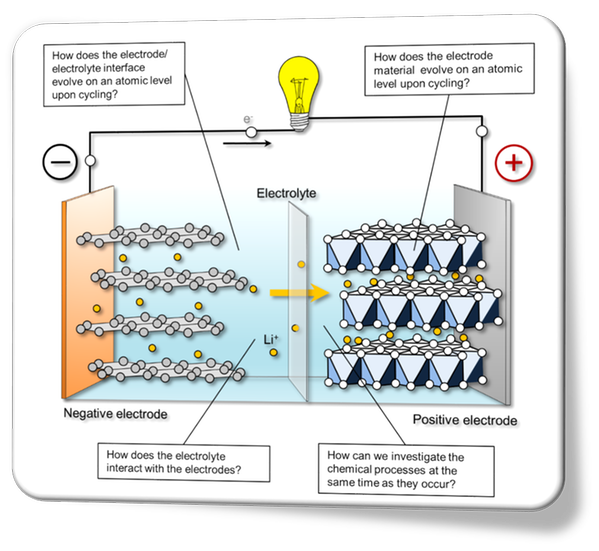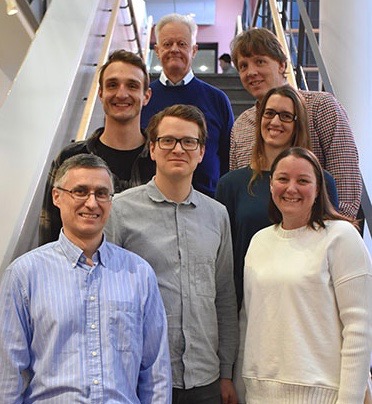Batteries

Batteries

The battery research in our division focuses on applying and developing x-ray based experimental techniques and methodologies for improved understanding of batteries and the reactions occurring during energy conversion. Our research focuses on both the interfaces between the electrodes and the electrolyte as well as on the function of the electrode materials and their evolution during charge and discharge.
A rechargeable battery is an electrochemical device that converts chemical energy into electrical energy and vice versa. The main parts of a battery are the two electrodes and the electrolyte and during battery operation these components may undergo oxidation and reduction reactions, forming new layers at the interfaces. The properties of these layers, especially the layer between the negative electrode and the electrolyte, are of great importance regarding not only battery performances but also battery safety and long-term stability. Information about the electrode materials, e.g. working principle, stability and reversibility is important for the development of new active materials suitable to achieve better batteries.
Most of the research at the X-ray Photon Science is based upon various spectroscopic techniques, and the division has a long track record of method and instrumental development. To investigate energy storage in batteries, photoelectron spectroscopy (link), X-ray absorption (link) and Resonant Inelastic X-ray Scattering (RIXS) (link) are primarily used. The battery research at the division is currently focusing on developing operando x-ray based techniques, where the electrochemical cycling of the battery will be performed in combination with the x-ray based characterisation. In operando battery techniques will primarily be developed for ambient pressure photoelectron spectroscopy (link) and RIXS.
People

Laurent Duda (Docent)
Maria Hahlin (Assistant Professor)
Ida Källquist (PhD student)
Fredrik Lindgren (Researcher)
Felix Massel (PhD student)
Bertrand Philippe (Researcher)
Håkan Rensmo (Professor)
Hans Siegbahn (Senior Professor)
Selected publications
Examples of published articles from the battery related research at the division.
Oxygen redox chemistry without excess alkali-metal ions in Na2/3[Mg0.28Mn0.72]O2
Urmimala Maitra, Robert A. House, James W. Somerville, Nuria Tapia-Ruiz, Juan G. Lozano, Niccoló Guerrini, Rong Hao, Kun Luo, Liyu Jin, Miguel A. Pérez-Osorio, Felix Massel, David M. Pickup, Silvia Ramos, Xingye Lu, Daniel E. McNally, Alan V. Chadwick, Feliciano Giustino, Thorsten Schmitt, Laurent C. Duda, Matthew R. Roberts, Peter G. Bruce
Nature Chemistry, 2018, DOI: 10.1038/nchem.2923
Breaking Down a Complex System: Interpreting PES Peak Positions for Cycled Li-ion Battery Electrodes
Fredrik Lindgren, David Rehnlund, Ida Källquist, Leif Nyholm, Kristina Edström, Maria Hahlin, Julia Maibach
The Journal of Physical Chemistry C, 2017, DOI: 10.1021/acs.jpcc.7b08923
Anion Redox Chemistry in the Cobalt Free 3d Transition Metal Oxide Intercalation Electrode Li[Li0.2Ni0.2Mn0.6]O2
Kun Luo, Matthew R. Roberts, Niccoló Guerrini, Nuria Tapia-Ruiz, Rong Hao, Felix Massel, David M. Pickup, Silvia Ramos, Yi-Sheng Liu, Jinghua Guo, Alan V. Chadwick, Laurent C. Duda, Peter G. Bruce
Journal of the American Chemical Society, 2016, 138, 11211-11218, DOI: 10.1021/jacs.6b05111
Charge-compensation in 3d-transition-metal-oxide intercalation cathodes through the generation of localized electron holes on oxygen
Kun Luo, Matthew R. Roberts, Rong Hao, Niccoló Guerrini, David M. Pickup, Yi-Sheng Liu, Kristina Edström, Jinghua Guo, Alan V. Chadwick, Laurent C. Duda and Peter G. Bruce
NATURE CHEMISTRY, 2016, 8, 684-691
Electric Potential Gradient at the Buried Interface between Lithium-Ion Battery Electrodes and the SEI Observed Using Photoelectron Spectroscopy
Julia Maibach, Fredrik Lindgren, Kristina Edström, Maria Hahlin
The Journal of Physical Chemistry Letters, 2016, 7, 10, pp 1775-1780, DOI: 10.1021/acs.jpclett.6b00391
Photoelectron Spectroscopy for Lithium Battery Interface Studies
Bertrand Philippe, Maria Hahlin, Kristina Edström, Torbjörn Gustafsson, Hans Siegbahn, Håkan Rensmo
Journal of The Electrochemical Society, 2016, 163 (2), A178-191, DOI: 10.1149/2.0051602jes
A HPXPS experimental method for characterization of solid-liquid interfaces demonstrated with a Li-ion battery system
Julia Maibach, Chao Xu, Susanna K. Eriksson, John Åhlund, Torbjörn Gustafsson, Hans Siegbahn, Håkan Rensmo, Kristina Edström, and Maria Hahlin
Review of Scientific Instruments, 2015, 85, 044101, DOI: 10.1063/1.4916209
Reaction cell for in situ soft x-ray absorption spectroscopy and resonant inelastic x-ray scattering measurements of heterogeneous catalysis up to 1 atm and 250° C
P.T. Kristiansen, T.C.R. Rocha, A. Knop-Gericke, J.H. Guo and L.C. Duda
Review of Scientific Instruments, 2013, 84, 113107
Nanosilicon Electrodes for Lithium-Ion Batteries: Interfacial Mechanisms Studied by Hard and Soft X-ray Photoelectron Spectroscopy
B. Philippe, R. Dedryvère, R. J. Allouche, J. F. Lindgren, M. Gorgoi, H. Rensmo, D. Gonbeau, D, K. Edström
Chemistry of Materials, 2012, 24, 1107
Research links
The division has a strong collaboration with the Department of Chemistry-Ångström and ÅABC, as well as with national and international synchrotron facilities such as MAX IV and ALS. The battery research is also linked to STandUP for energy research platform connecting groups doing energy related research at Uppsala University, Kungliga Tekniska Högskolan and Stockholm University. The division also have independent collaborations with the University of Oxford, Karlsruhe Institute of Technology and are involved in large European projects involving many European battery research teams.
Master and Bachelor projects
We invite students interested in master and bachelor projects. For more details about available projects, please contact Maria Hahlin.
Contact
- Programme Professor Condensed Matter Physics of Energy Materials
- Håkan Rensmo
- Head of Division X-ray Photon Sciences
- Nicusor Timneanu
